Role plays give students a real purpose for communication, develop speaking fluency and accuracy, and can be really engaging! And not only that, they offer listening practice and are a great way to liven up a lesson. However, each role play needs to be approached differently. Take a look at the tips for a successful ESL role play to see what to do before, during and after a role play to make the most of it.
Getting ready for a role play
With most role plays, it makes sense to teach and provide some controlled practice of the language that students will need. Alternatively, pick a task that looks doable for your students and do some work with the emergent language after the role play if necessary.
It is always worth taking a moment before any role play to make sure students understand what the task entails. This can be done using concept check questions. For instance, before the role play from the lesson What makes a good listener?, after students see the instructions and get their own card, ask them: How long do you need to talk for? How many topics do you need to talk about? How many follow-up questions do you need to ask?


You might also decide to help students work out the logistics, e.g. establish who will go first, or, in the case of an uneven number of students in the group, what will be different for the group of three.
Depending on what the participants are expected to do, some role plays require preparation time for students. They might have to brainstorm ideas, take some notes or just think things through before they start. However, giving students too much time could, in some cases, defeat the purpose of the role play. For instance, you don’t want your students to write down what they are going to say word for word.
Take the role play from the lesson I’m afraid that’s outside the scope of this meeting.
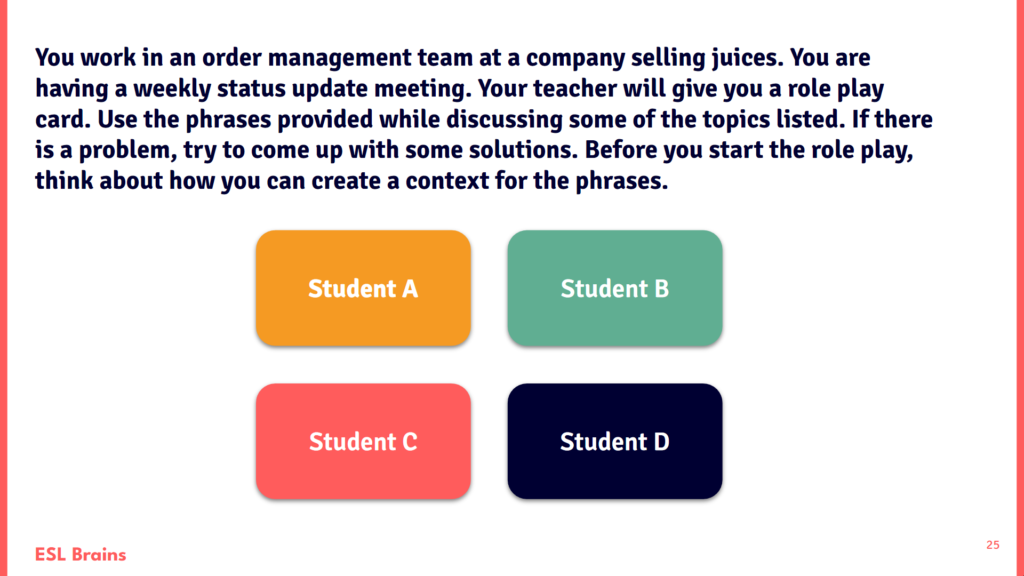
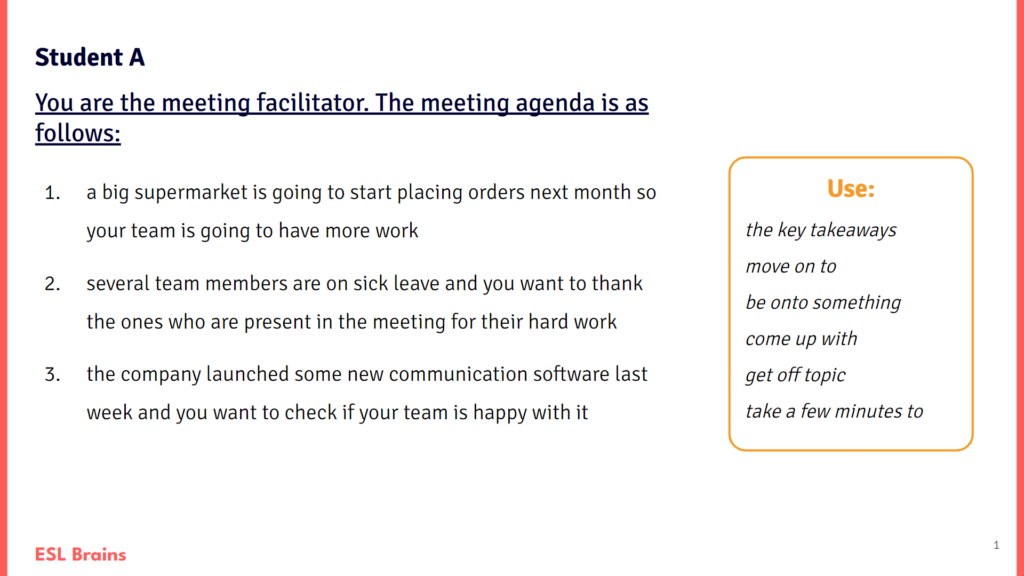
With this one, you’ll probably want to give students some time to prepare. They need to think about how to incorporate the phrases in the box into what they are going to say. This will, however, depend on the group – a confident bunch of students may not need that much time to prepare.
The role play from the lesson Have you tried turning it off and on again? is completely different.
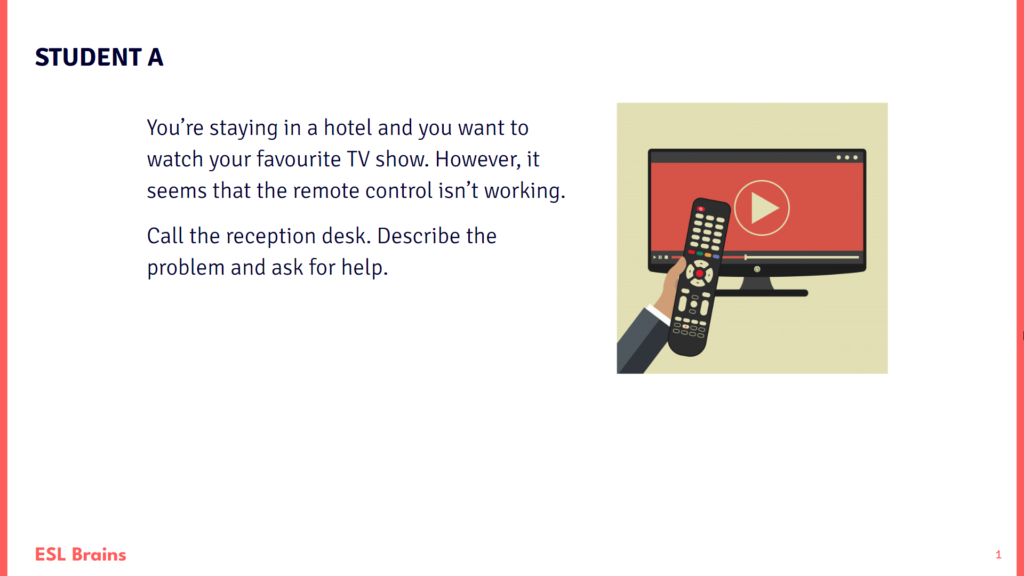
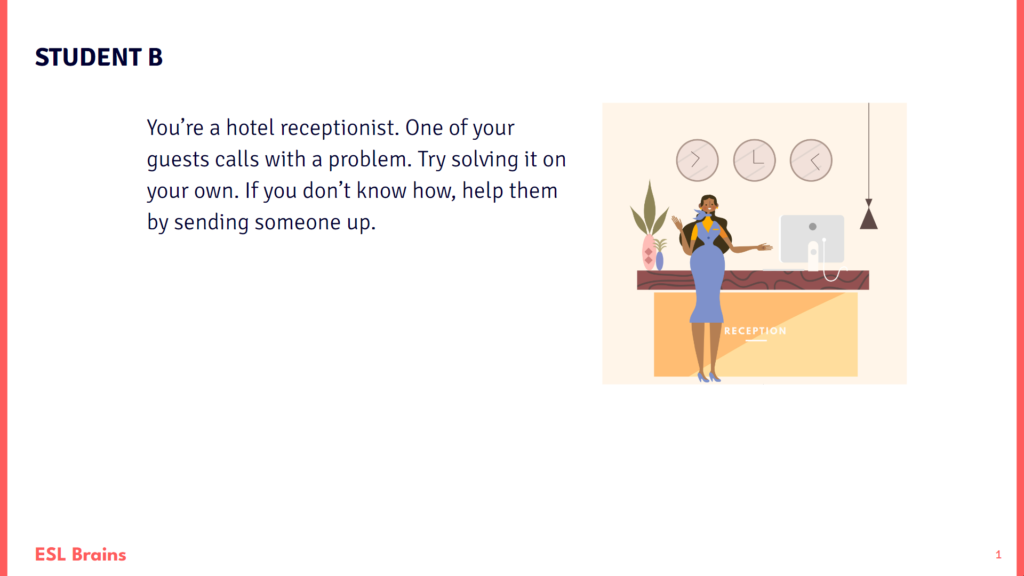
There is really no point in giving students any preparation time here. They don’t know what their partner is going to say, so they just have to think on their feet and react the best way they can. This can be challenging for students who are not used to speaking but the more speaking opportunities they get, the more confident they become.
Ideas for a great finish to a successful ESL role play
Every successful ESL role play needs some feedback. If you manage to take notes while students are doing the task, now is the time to tell them what their strengths were. You can also ask them to correct some of the mistakes they made (without pointing fingers). If your students do a role play twice, it’s probably better to provide feedback after the first iteration so that they make fewer mistakes on the second try.
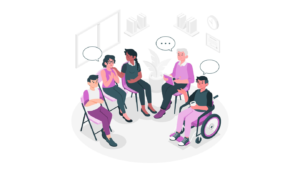
You should also let your students share their opinions about the task. They could tell you which part was the most challenging, what they would say differently if given another chance, or if they felt the activity was helpful. Their answers might give you some insights into preparing or choosing role plays for future lessons.
A follow-up activity can be a good idea to do as homework. Remember the role play with a broken remote? Your students could write similar role play cards, just changing what is broken and the location of the conversation. You could then use the role play cards as revision at the beginning of the next lesson. And after a role play with follow-up questions, you could tell your students to use the topic they didn’t talk about and write five questions around it to ask their partner in the next lesson. Or even encourage your students to practise the scenarios again on their own, looking in the mirror or recording themselves.
Repeat and reuse
Some role plays are worth repeating in different configurations. The aim of the role play below, taken from the lesson I wish I could but I don’t want to, is to practise different ways of saying ‘no’ politely.


Once pairs finish the role play, consider putting students into new pairs and changing roles. This will allow them to use what was said in the first conversation and build on that to make the role play longer, but also to use the ‘no’ phrases with more confidence and maybe even add new ones. Make it clear for students that you want them to come up with more ways to encourage a colleague to go out and more ways of declining invitations. Also, if your students used notes while doing the task for the first time, you can ask them not to use them during the second try. In other words, if you decide to do a role play more than once, change some details to make it just a bit more challenging for students. Don’t let them get bored!

Most role plays can be used in a one-to-one setting without introducing any changes but there are some things to consider. For example, some role plays don’t offer ‘equal’ roles, as one person might need to speak longer or use the target language more. Consider the first role play in this article in which students need to ask their partner follow-up questions. With an individual student, think about whether you want them to first hear your follow-up questions (as inspiration or revision) or if you want them to focus on creating questions first and on fluency second. This will help you decide which role they should take first. You can also make a role play more or less challenging for an individual student by paying attention to: how much you say versus how long you wait for them to say something without a prompt; whether you want to cause them ‘problems’ by complicating the situation or let the conversation take a predictable path.
Small changes can really make a difference
A successful ESL role play will help your students become more confident English speakers and communicate better outside the classroom. Don’t underestimate the value of a good start and a good finish to role plays. And remember that reusing role plays in various settings and with varying degrees of difficulty can make a huge difference. Use the tips and let us know how it went!



Thank you for the article. As an ardent proponent of role plays, I couldn’t agree more with everything said here. I particularly love the idea of students creating their own scenarios to be further explored in subsequent lessons.
Thanks, Tania! Happy to hear you liked the article 🙂